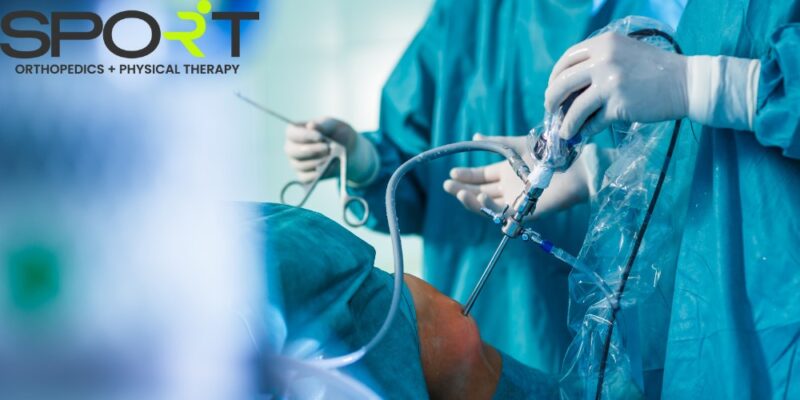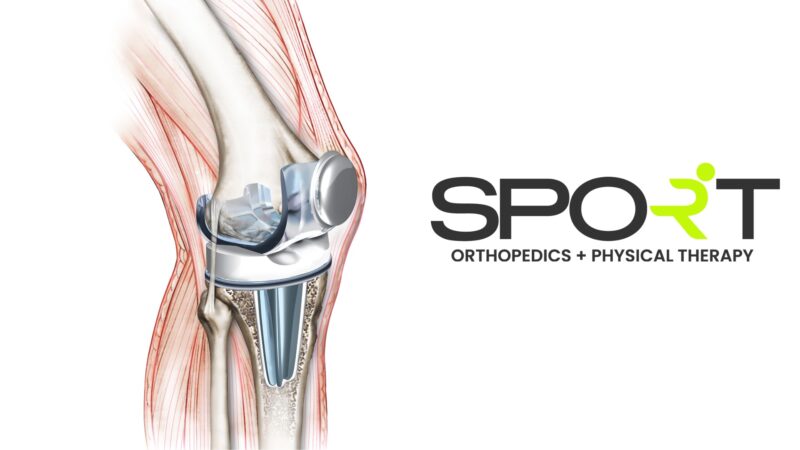Robotic Knee Replacement Surgery in Dallas, Frisco, Plano and Wylie TX
What to Expect from Robotic Knee Replacement Surgery
What Is Robotic Knee Replacement?
Robotic knee replacement is similar to regular knee replacement surgery, with the only difference being that a robotic arm or handheld robotic device assists the surgeon. While your surgeon can perform the knee replacement on their own, using robotic technology improves accuracy and precision. Whether you’re undergoing robotic knee replacement or regular knee replacement surgery, your results are only as good as your surgeon.
Types of Robotic Knee Replacement Surgery
At SPORT, we offer one of the leading forms of robotic-assisted knee replacement technology, the Mako Robotic-Arm Assisted surgery system. The Mako system can be used for partial knee replacements or total knee replacements. It differs from other types of robotic-assisted knee replacements in two ways. First, it uses specific scans of your knee before surgery to accurately measure your knee.
Secondly, the Mako system offers a different approach to guiding the surgeon through the surgical plan. Prior to the surgery, your surgeon will create a 3D image of your knee using the CT scan. The virtual model of your knee and surrounding tissues will give the surgeon a detailed picture when planning the surgery so that they can precisely position and fit the implant into your knee.

What Happens During Robotic Knee Replacement Surgery?

Prior to surgery, your surgeon will use your CT scan to create a 3D model of your knee. Using this model, your surgeon will evaluate your bone structure, joint alignment, disease severity, and surrounding bone and tissue to determine the implant’s optimal size, placement, and alignment. During the procedure, the Mako system provides real-time data to the surgeon and medical team to assess the movement and tension in your new joint and make any adjustments to the surgical plan.
Using the Mako robotic arm, the surgeon will remove the arthritic bone and cartilage using a virtual boundary to help the surgeon stay within the boundaries of the surgical plan. Once the diseased bone is removed, the implant is inserted into the knee joint, and recovery can begin.
Who Is a Good Candidate for Robotic Knee Replacement Surgery?
Anyone that is a candidate for a traditional knee replacement is also likely a candidate for robotic-assisted surgery. If you suffer from any of the following, a robotic knee replacement might be a good option for you.
- Femur damage that resulted from an injury
- Damage on or around the knee
- Hardware in the femur or tibia near the knee from previous surgeries
- Advanced osteoarthritis caused by normal, age-related changes like thinning cartilage
If you’re interested in robotic surgery for your knee pain, it’s important to discuss this with your orthopedic surgeon first to determine the best options for you.
Advantages of Robotic-Assisted Knee Replacement Surgery
Typically, total knee replacement surgery has a high level of satisfaction. Whether the surgery was traditional or a robotic-assisted procedure, the satisfaction rate is around 95%. Robotic technology allows orthopedic surgeons to make small micro-adjustments during the procedure to improve implant positioning and alignment. The soft tissue surrounding the knee joint is less likely to be disturbed or damaged by precisely positioning the saw blade. The less disruption around the joint can result in a shorter recovery time for the patient. Robotic-assisted procedures are especially beneficial for patients with prior knee trauma, surgeries, or deformities.
Risks and Complications of Robotic Knee Surgery
With any surgery, there will be a certain level of risk. Robotic knee replacement surgeries come with the same risks as traditional knee replacements. Patients undergoing knee replacements are at risk for nerve damage, blood clots, infections, and allergic reactions to the artificial joint. Doctors hope the risks can be reduced with robotic surgery since the incision site is smaller than traditional surgery, and the robotic assistant allows for greater precision. Most knee replacements are successful with very slim complications. Only about 2% of knee replacement patients experience serious complications.
Traditional Knee Replacement Surgery vs Robotic Knee Replacement

During robotic knee replacement, the surgery is not performed solely by the robot. The robotic arm is more of a guide for the surgeon to follow using the pre-plan laid out prior to the surgery. The orthopedic surgeon remains in complete control, like traditional knee surgery, but uses the robotic arm as an additional tool to enhance their surgical skills. The robotic surgical assistant helps the surgeon perform a more precise procedure, resulting in an even better outcome than traditional surgery.
Is Robotic or Traditional Knee Replacement Surgery Better?
Using robotic techniques for partial knee replacement or total knee replacement is still relatively new in the medical community. It has increased, though, with more surgeons performing robotic-assisted knee surgeries because they allow for fewer complications. Robotic-assisted surgery guides the surgeon through the procedure using the pre-surgery plan and making smaller incisions disrupting the surrounding tissue. There is evidence that robotic surgery delivers better results than traditional, but more research is required.
How Long Does It Take to Recover from Robotic Knee Replacement?

According to a study published in Arthroplasty Today, robotic-assisted knee replacement surgeries have a lower complication rate in the first three months of recovery. Traditional knee replacement surgeries have a recovery time of four to six months, robotic knee patients seem to recover faster because of less trauma to the knee. A quicker recovery time means that patients can return to their active lifestyle in a shorter time. The potential for a shorter recovery time is due to smaller incisions and greater surgical precision, which means less tissue and bone is disturbed, speeding up the healing process.
What Is the Success Rate of Robotic-Assisted Knee Surgery?
Knee replacement surgeries have a very high success rate. Since robotic joint replacement surgery allows the surgeon to use greater precision, the results are still high for surgical success, although it is not guaranteed. The patient is always at risk when undergoing any surgical procedure.
Contact the Knee Replacement Specialists at SPORT Orthopedics + Physical Therapy
Whether you need a partial or total knee replacement, let the best Dallas orthopedic surgeons at SPORT help you get back on your feet. We will evaluate your knee pain and determine if you are a candidate for robotic knee replacement using the Mako Robotic Assisted Arm. Call (469) 200-2832 to schedule an appointment today to discuss the surgical and non-surgical options available to relieve knee pain.


